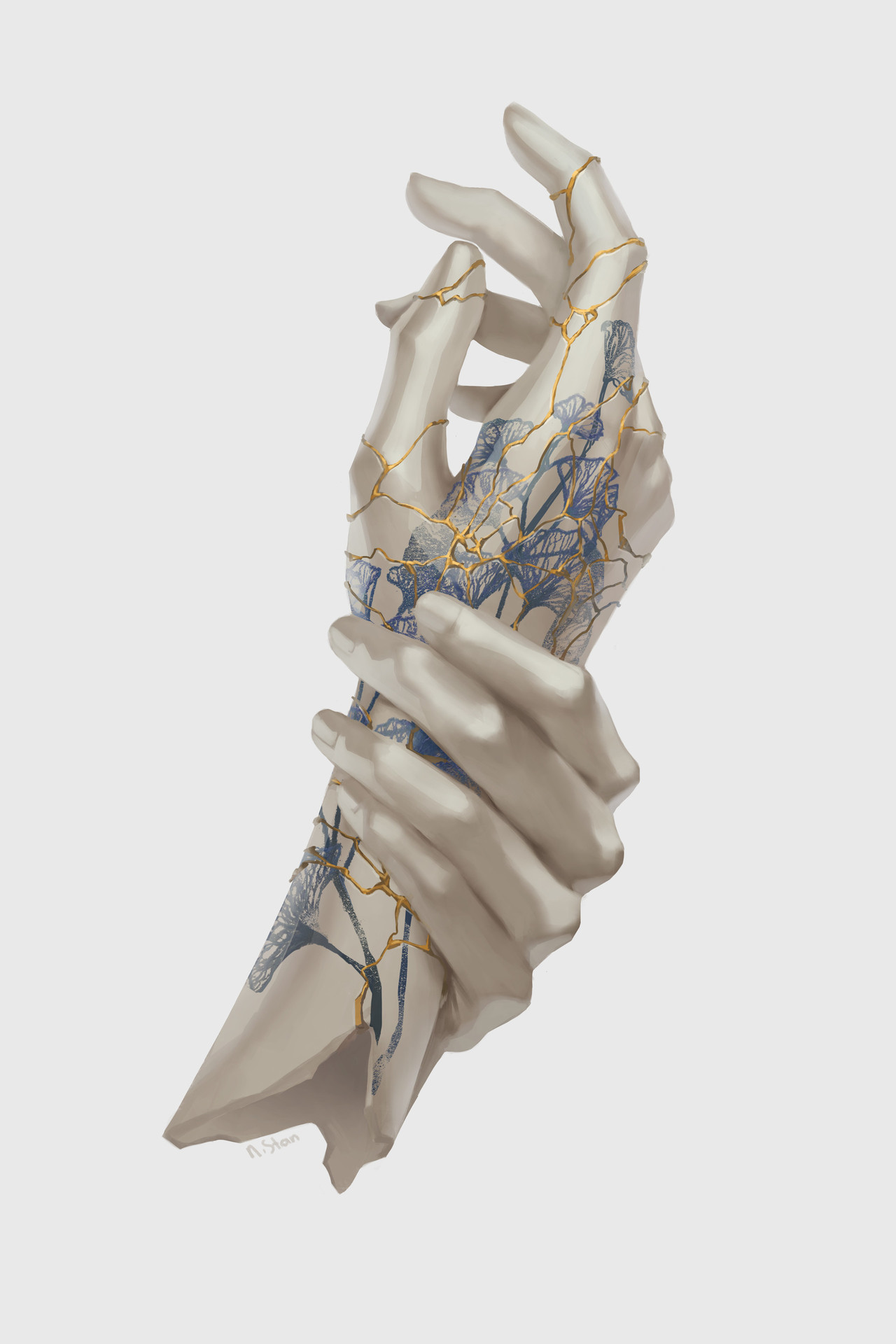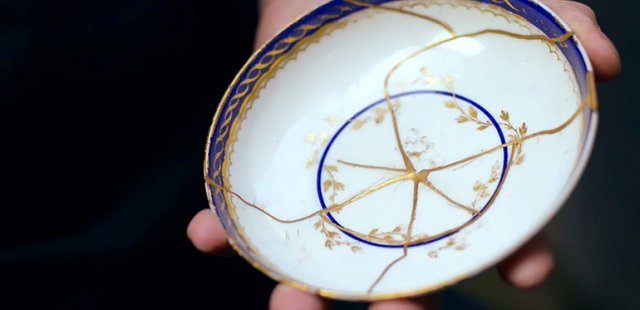Guest post by @ailindigo: Kintsugi: defects as virtues, the beauty of scars and resilience
The Western way of seeing fractures, both materially and emotionally, is totally different from the Oriental way; in the West we discard broken objects because they stop serving us, whereas in the East their function is transformed into another: in a message, the broken object stops being a thing and becomes a graphic gesture that calls us to imitate its great transformation. This is kintsugi, a practice that poses the acceptance of breaks as part of the history of an object and therefore must be shown and not hidden, as the scars embellish the object by showing its transformation.

Art of Natalie Stan
Kintsugi literally means "golden bond" and is the Japanese practice of repairing broken objects by highlighting the cracks that mark the rupture, using varnish or resin sprinkled with gold. The Japanese pose with this art that cracks, fractures or ruptures are part of the history of an object, make it unique and therefore there is great beauty in the scar or mark that must be exalted for us to be able to confer it a greater value.
Because for kintsugi artists the fissures or scars should not be hidden, the restoration process does not consist of hiding that a rupture once existed, but quite the opposite. Once the object has been broken or at least cracked, a resin paste is placed and gold is sprinkled before being allowed to dry. In this way, the restoration of the object represents an exaltation, a revaluation of it from its history, a celebration of its defects instead of pretending that they never existed.
This is a practice in which we not only find an aesthetic theory but a very deep vision of reality. Behind kintsugi lies a notion that celebrates the fragility of things and their accidents, unlike the Western idea that beauty is perfection. Repairing broken pieces of pottery in such a way that no cracks are noticed would represent a denial to the events of nature and its reality, and not only that, by not repairing the pieces we would have no reminder of imperfection and impermanence, extolled by the aesthetic idea that is to mix the golden dust with the scar.
Kintsugi makes the fragility and impermanence of things visible by highlighting the cracks of the rupture, as contemplative objects, as if trying to make us see the catastrophe but without wanting to repair them in an impulsively perfect way. Christy Bartlett writes in Flickwerk: The Aesthetics of Mended Japanese Ceramic:
“Not only is there no attempt to hide the damage, but the repair is literally illuminated… a kind of physical expression of the spirit of mushin… Mushin is often literally translated as “no mind,” but carries connotations of fully existing within the moment, of non-attachment, of equanimity amid changing conditions. …The vicissitudes of existence over time, to which all humans are susceptible, could not be clearer than in the breaks, the knocks, and the shattering to which ceramic ware too is subject. This poignancy or aesthetic of existence has been known in Japan as mono no aware, a compassionate sensitivity, or perhaps identification with, [things] outside oneself.”

Source
On the other hand, we have that resilience is the ability of a person to overcome adverse circumstances or emotional pain, a term that comes from dentistry and refers to the ability of the soft tissues of the teeth to regenerate once fissured. Kintsugi seems to me also applicable to life; when we suffer a traumatic or negative experience or circumstance that has left its mark on us, let’s not try to do as if nothing had happened, on the contrary, let’s recognize it and embrace it, let’s celebrate what it has left or given to our lives, let’s be resilient and learn to allow to each traumatic event of our existence to make us more valuable and wise people, to evolve.
Those broken pottery vessels, cracked, with their fissures, wounds, are a kind of mirrors in which we may be able to see ourselves and accept our nature of change, degradation and error; as fragile as porcelain or clay, but in the same way beautiful in transformation, especially in the moments where those adversities have hit us, but which have made us grow, wiser and more sensitive. Is not vulnerability what allows us to join a person and establish a bond of intimacy with him/her? The poet Rumi said that "the wound is the place where the light enters you". The crack represents a space and possibility of interpenetration, a glimpse of openness.
I have always considered scars as something worthy of admiration, I like to say that they are the best tattoos, because they represent a more real pain, something almost to show off. Kintsugi is to find something valuable unexpectedly and by chance due to a slip, a crack where we get the lighting, an exaltation of the flaws above the virtues. Undoubtedly, kintsugi is an art, a metaphor in which the scar becomes an opportunity to face the world silently.
“The world breaks everyone and afterward many are strong at the broken places.”
Ernest Hemingway
This content is a manual translation of an article of mine that was originally in spanish and posted 6 months ago on my blog. I wanted to share it with the english-speaking community through this opportunity. This translation was made by myself @ailindigo, the original author, and you can read the post in spanish here.

Culture is the aboriginal nature for us,we are always carry this culture our mind.
Posted using Partiko Android
Culture is one of the most important issues of humankind I think :)
I try to comment sir @bulleth, I hope you dont mind.
What I understand from your writing is that Kintsugi is a theory that refuses to achieve perfection and beauty does not always have to emerge from an ideal theory. A person can rise from limitations and shortcomings can be a way to achieve success as long as the person is able to correct these deficiencies and make the past as a lesson and the initial foundation of success.
Kitsugi is also a characteristic of someone who has a vision of a good future and it has been proven that the Hiroshima Nagasaki bomb did not make the Japanese spirit down, but the spirit of awakening and it is proven that today Japan is a successful country.
I hope my understand correctly, if I'm wrong I beg you to be repaired. Thank you for this information sir @bulleth.
Posted using Partiko Android
Yeah! you're totally correct, sir! That's the way I see it, flaws can be a way of achieving success, hence its importance in life. I think if humans saw flaws and mistakes this way they would improve their way of facing troubles in life and they would be kinder with each other and themselves.
Thanks for your comment! :)